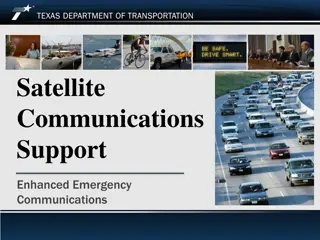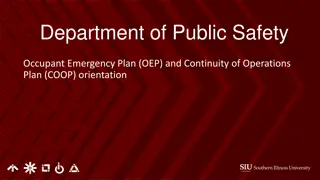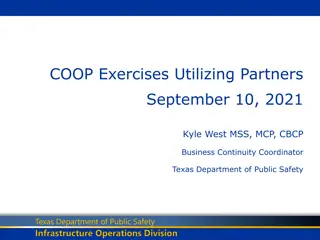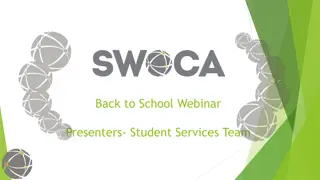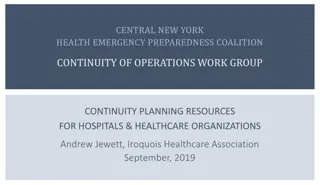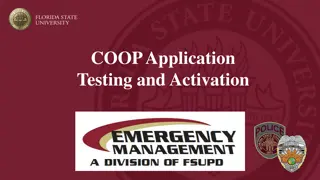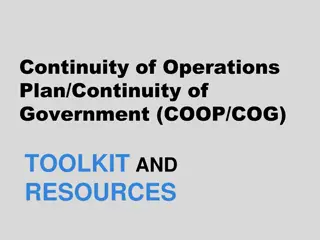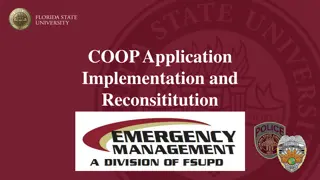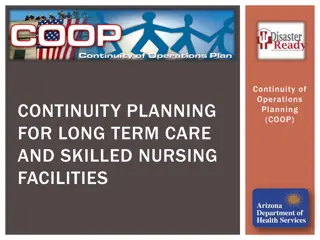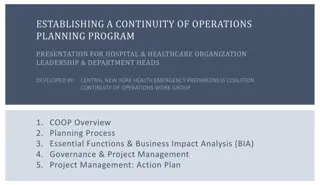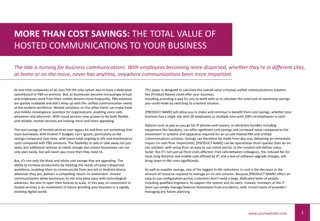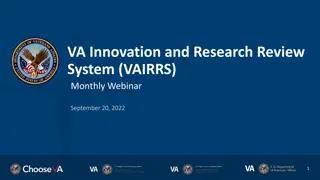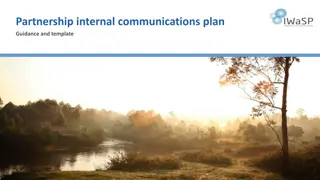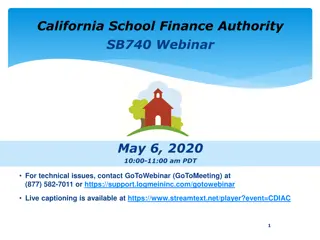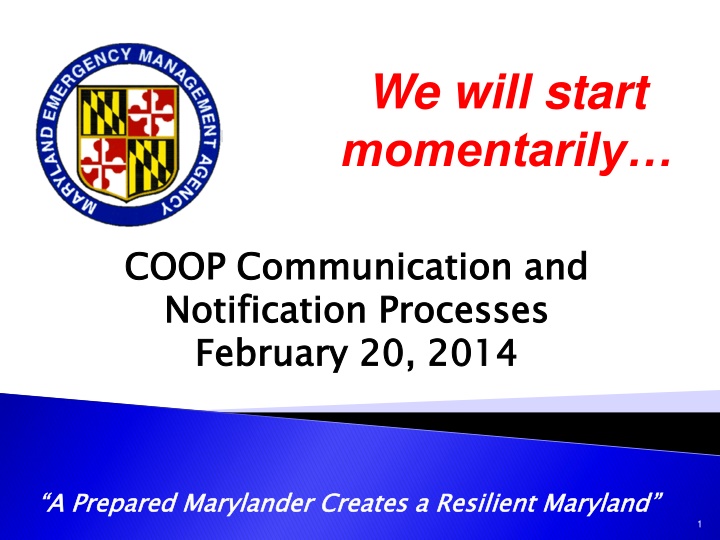
COOP Communication and Notification Processes Overview
"Learn about COOP communication and notification processes, essential for building a resilient Maryland. Understand the crucial elements of technology and business practices in communications planning. Presented by experts from the University of Maryland Center for Health and Homeland Security."
Download Presentation

Please find below an Image/Link to download the presentation.
The content on the website is provided AS IS for your information and personal use only. It may not be sold, licensed, or shared on other websites without obtaining consent from the author. If you encounter any issues during the download, it is possible that the publisher has removed the file from their server.
You are allowed to download the files provided on this website for personal or commercial use, subject to the condition that they are used lawfully. All files are the property of their respective owners.
The content on the website is provided AS IS for your information and personal use only. It may not be sold, licensed, or shared on other websites without obtaining consent from the author.
E N D
Presentation Transcript
We will start momentarily COOP Communication Notification Processes February 20, 2014 COOP Communication and Notification Processes February 20, 2014 and CPP A Prepared Marylander Creates a Resilient Maryland A Prepared Marylander Creates a Resilient Maryland 1
COOP Communication Notification Processes February 20, 2014 COOP Communication and Notification Processes February 20, 2014 and CPP A Prepared Marylander Creates a Resilient Maryland A Prepared Marylander Creates a Resilient Maryland 2
Session participants will remain muted Type questions in Questions Pane Feedback survey Audio problems? http://bit.ly/AudioHelp Recorded, will be available over MEPP 3
Introductions Background & Definitions Review Processes Communications & Essential Functions Technology Business Practices Communications Plan Conclusion Contact Information At this point in the presentation you should be able to hear the presenter speaking. Should you experience audio problems please visit http://bit.ly/AudioHelp 4
Presenters: Preeti Emrick & Marissa Clark, University of Maryland Center for Health and Homeland Security About CHHS: Created after 9/11 attacks To bolster UMB s work related to homeland security Works with emergency managers and responders in the private sector & all levels of government Develops plans, policies, and strategies Enhance & ensure public safety during natural disasters or man-made catastrophes 5
Communications planning crucial to COOP planning Two Major Elements of Communications: 1. Technology - Devices that channel & facilitate communication; should be accessible, secure, and redundant Interoperability - Ability of a system or product to work with other systems or products without special effort on the part of the user 2. Business Practices - Comprehensive office policies that foster and promote effective and timely communication before/during/after an emergency 6
Review Critical Communication Processes Review Critical Communication Processes Initiation (Who, Where, How, etc.) Receipt (Who, Where, How, etc.) Desired Outcome 7
Identify Communication Requirements and Equipment Location Urban or Rural Internal or External Fixed or Mobile Type Two-way (2 people or conference call) One-way Identify Communication Requirements and Equipment Don t forget transit capabilities for senior leadership Don t forget alternate facility locations and mobile, in- 8
Communications systems should be able to: Operate: At an alternate facility within 12 hours, and for up to 30 days At a capability commensurate with an agency s essential functions, data, and systems In situations with and without warning Communications systems should be able to: Communicate with: COOP Planning Team, agency leadership & management, essential personnel, & other employees Clients, stakeholders, vendors, & emergency personnel 9
For each essential function, consider which of the following systems are used: For each essential function, consider which of the following systems are used: Voice lines Fax lines Data lines Cellular phones Email VOIP (Voice-Over- Internet-Protocol) Internet access Instant Messenger Services Radio Communication Systems Pagers Satellite Phones Smart phones 10
Identify key information for every communication service provided, including: Identify key information for every communication service provided, including: Current provider Services provided Special/emergency services provided or available 11
Identify alternative modes of communication: List alternate providers for communications systems List alternate modes of communications Identify alternative modes of communication: Alternative Cell phones GETS (Government Emergency Telecommunications Service) Independent radio operators (HAM, CB, RACES) Alternative modes of communications include modes of communications include: 12
Preventative controls attempt to avoid occurrence of unwanted disruptions such as data loss through power outages, equipment malfunction, & destruction Examples: UPS Air conditioning systems despite failure of certain components Fire and smoke detectors Water sensors Gas or diesel powered generators Emergency master shutdown switch Technical security controls UPS to provide short-term backup power to system components Air conditioning systems with excess capacity : continue functioning Fire and smoke detectors and fire suppression systems Water sensors in ceiling and floor for computer & telecom rooms Gas or diesel powered generators for long-term backup power Emergency master shutdown switch Technical security controls fire suppression systems 13
Signed agreements with other agencies/organizations that share facility Sufficient quantity of interoperable and available communications capabilities to meet agency s responsibilities during emergency Communications capabilities that support agency s senior leadership while they are in transit Identify programs & acquisition vehicles Annually review continuity communications 14
Communication with Employees Provide employees with an emergency call-in phone number, website, or electronic message board Communication with Employees Annually update written procedures for dismissal or closure Determine when employee s formal or informal telework agreement may need to be amended Remember accessibility of individuals with special needs Agency managers may want to develop terms and procedures to announce operating status 15
Create List) Rapid Recall List - a cascading list in order of notification of key agency personnel and outside emergency personnel Create a a Personnel List) Personnel Contact List (Rapid Recall Contact List (Rapid Recall Includes list of first responders and key agency personnel 16
May wish to include following information for each contact on RRL: Name/Title Email address Work number Home number Cell or pager number Emergency Contacts Distance from main office and alternate facility Other relevant information May wish to include following information for each contact on RRL: 17
External External contacts and vendors should be listed as required resources supporting those functions Include contact information for external vendors, suppliers, or others who would most likely need to be contacted if agency s COOP plan is activated External Call List/Contacts Call List/Contacts 18
Examples of additional notification measures to make within 12 hours of activation: Notify all current active vendors, contractors, and suppliers: COOP activation Direction on activities that will need to be altered, suspended, or enhanced Examples of additional notification measures to make within 12 hours of activation: As appropriate and necessary, notify primary points of contact for surrounding organizations & jurisdictions: COOP activation Any potential consequences Planned alternate actions that might be required until normal operations can be restored 19
Identify key personnel (decision makers) May relate to Order of Succession/Delegations of Authority Have employee contact roster kept in convenient method Verify redundancy Activation considerations Plan to notify key personnel Plan to notify all personnel 20
Develop and maintain a communication plan for all employees: Regular, accurate, and effective communications to all employees Updating information as necessary Procedures for securing worksite Provisions for safeguard of vital records Employees must be kept informed during emergencies whether they work at the alternate site or not Poor emergency communications can lead to unnecessary anxiety or indifference in the workforce 21
All employees need to be informed during the course of an emergency so that they can be ready to go back to work when recalled or to support their agencies efforts from home In a COOP event, most employees will be expected to: Go home Remain available Wait for further directions Management s responsibility to know where all employees are and how to contact them 22
Tell non Where to go Tell non- -essential members: essential members: What to do (alternate assignments for non- emergency employees) Include employee accountability procedures Include recall/activation procedures 23
Key questions to consider for notification procedures to alert the COOP Team, key personnel, and others: Who is responsible for contacting key personnel? What protocols or procedures are utilized to contact key personnel during day-to-day operations? During emergency situations? Does the agency currently use notification software or systems to notify leadership and staff (e.g., reverse 911, automated call tree, text message, or others)? 24
Consider using the following terms to announce the operating status of the agency: Open Open under an unscheduled leave policy Open under a delayed arrival policy Open under a delayed arrival/unscheduled leave policy Early dismissal Closed 1. 2. 3. 4. 5. 6. 25
Prepare message with explicit instructions for key personnel once they have been notified of COOP activation Examples- Arrive at designated meeting location within two hours for initial assessment. Within three hours, activated personnel assemble at the alternate facility location. 26
Contact person representative from media relations or, at least, designate media contact person Responsible for: Preparing press releases Regularly speaking with media regarding agency s response Prepare template for media release that provides: Public information on impact of operations Plans to restore services Use of social media 27
Examples of additional public notification measures within 12 hours of activation include: COOP Coordinator notifies the Public Information Officer (PIO) of activation and coordinates any necessary press release or public messages Examples of additional public notification measures within 12 hours of activation include: The COOP Coordinator, in conjunction with the PIO, provides alert, notification, and guidance to support personnel and the public 28
COOP and family support plans should include: Personnel accountability procedures COOP and family support plans should include: A means for keeping employees informed (call-in number) Info on developing family emergency plans Info about family support services near alternate site Procedure for contacting family of employees who will be relocated A means for two-way communication between essential/key members and their families 29
QUESTIONS? 30
Audrey Cain -MEMA- (audrey.cain@maryland.gov) Jane J. Thursby -MEMA- (jane.thursby@maryland.gov) 31

